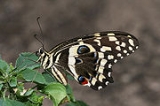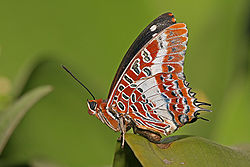
Papilionoidea
Encyclopedia

Taxonomic rank
In biological classification, rank is the level in a taxonomic hierarchy. Examples of taxonomic ranks are species, genus, family, and class. Each rank subsumes under it a number of less general categories...
Papilionoidea (from the genus Papilio, meaning "butterfly") contains all the butterflies
Butterfly
A butterfly is a mainly day-flying insect of the order Lepidoptera, which includes the butterflies and moths. Like other holometabolous insects, the butterfly's life cycle consists of four parts: egg, larva, pupa and adult. Most species are diurnal. Butterflies have large, often brightly coloured...
except for the skipper
Skipper (butterfly)
A skipper or skipper butterfly is a butterfly of the family Hesperiidae. They are named after their quick, darting flight habits. There are more than 3500 recognized species of skippers and they occur worldwide, but with the greatest diversity in the Neotropical regions of Central and South...
s, which are classified in superfamily Hesperioidea, and the moth-like Hedyloidea.
A proposed phylogenetic position of the Papilionoidea is as follows:
Some authors treat this group as a series Papilioniformes within a single superfamily that also includes the skippers. However not all authors agree that all the butterflies constitute a single clade
Clade
A clade is a group consisting of a species and all its descendants. In the terms of biological systematics, a clade is a single "branch" on the "tree of life". The idea that such a "natural group" of organisms should be grouped together and given a taxonomic name is central to biological...
. The skippers are significantly different from the other butterflies. The members of the Papilionoidea may be distinguished by the following combination of characters:
- the body is smaller and less moth-like.
- the wings are larger.
- the antennaAntenna (biology)Antennae in biology have historically been paired appendages used for sensing in arthropods. More recently, the term has also been applied to cilium structures present in most cell types of eukaryotes....
e are straight and clubbed (rather than hooked as in the skippers). - the caterpillarCaterpillarCaterpillars are the larval form of members of the order Lepidoptera . They are mostly herbivorous in food habit, although some species are insectivorous. Caterpillars are voracious feeders and many of them are considered to be pests in agriculture...
s do not spin cocoons to pupaPupaA pupa is the life stage of some insects undergoing transformation. The pupal stage is found only in holometabolous insects, those that undergo a complete metamorphosis, going through four life stages; embryo, larva, pupa and imago...
te in. - the pupae are angular rather than rounded.
Families of Papilionoidea
The five well-supported families of Papilionoidea are:- SwallowtailSwallowtail butterflySwallowtail butterflies are large, colorful butterflies that form the family Papilionidae. There are over 550 species, and though the majority are tropical, members of the family are found on all continents except Antarctica...
s and BirdwingBirdwingBirdwings are papilionid butterflies native to the Indian Subcontinent, mainland and archipelagic Southeast Asia and Australasia, and are usually regarded as belonging to three genera: Ornithoptera, Trogonoptera and Troides. Some authorities include additional genera...
s, Papilionidae - WhitePieridaeThe Pieridae are a large family of butterflies with about 76 genera containing approximately 1,100 species, mostly from tropical Africa and Asia. Most pierid butterflies are white, yellow or orange in coloration, often with black spots...
s or Yellow-Whites, PieridaePieridaeThe Pieridae are a large family of butterflies with about 76 genera containing approximately 1,100 species, mostly from tropical Africa and Asia. Most pierid butterflies are white, yellow or orange in coloration, often with black spots... - Blues and CoppersLycaenidaeThe Lycaenidae are the second-largest family of butterflies, with about 6000 species worldwide, whose members are also called gossamer-winged butterflies...
or Gossamer-Winged Butterflies, LycaenidaeLycaenidaeThe Lycaenidae are the second-largest family of butterflies, with about 6000 species worldwide, whose members are also called gossamer-winged butterflies... - Metalmark butterfliesRiodinidaeThe Riodinidae are a family of butterflies. The common name "metalmarks" refers to the small metallic-looking spots commonly found on their wings. There are approximately 1,000 species of metalmark butterflies in the world...
, RiodinidaeRiodinidaeThe Riodinidae are a family of butterflies. The common name "metalmarks" refers to the small metallic-looking spots commonly found on their wings. There are approximately 1,000 species of metalmark butterflies in the world... - Brush-footed butterflies, NymphalidaeNymphalidaeThe Nymphalidae is a family of about 5,000 species of butterflies which are distributed throughout most of the world. These are usually medium sized to large butterflies. Most species have a reduced pair of forelegs and many hold their colourful wings flat when resting. They are also called...
which contain the following 13 subfamilies:- the snout butterflies or LibytheinaeLibytheinaeLibytheinae is the nymphalid subfamily of the snout butterflies, containing two valid genera and about 10 species, 6 in Libythea and 4 in Libytheana. The common name refers to the thick labial palps that look like a "snout" in this subfamily. In older literature, this group was recognized as the...
(formerly the family Libytheidae). - the Danaids or Danainae (formerly the family Danaidae).
- the Tellervinae.
- the glasswings or Ithomiinae.
- the CalinaginaeCalinaginaeCalinaginae is a butterfly subfamily from the family Nymphalidae. This group of butterflies includes one genus, Calinaga, that occurs in Asia.-Classification:*Calinaga lhatso Oberthür, 1893*Calinaga buddha Moore, 1857 - The Freak...
. - the morphos and owls or MorphinaeMorphinaeMorphinae is a subfamily of Nymphalidae butterflies that includes the morphos, the owl butterflies and related lineages. It is either considered a sister group of the Satyrinae, or disassembled and included therein.- Systematics :...
(including the owls as tribe Brassolini). - the Browns or SatyrinaeSatyrinaeSatyrinae, the satyrines or satyrids, commonly known as the Browns, is a subfamily of the Nymphalidae . They were formerly considered a distinct family, Satyridae. This group contains nearly half of the known diversity of brush-footed butterflies...
(formerly the family Satyridae). - the CharaxinaeCharaxinaeCharaxinae, the leafwings, is a nymphalid subfamily of butterflies that includes about 400 species, inhabiting mainly the tropics, although some species extend into temperate regions in North America, Europe, China and southern Australia. There are significant variations between the species...
(preponas and leaf butterflies). - the BiblidinaeBiblidinaeBiblidinae is a subfamily of nymphalid butterflies that includes the tropical brushfoots. This subfamily was sometimes merged within the Limenitidinae, but they are now recognized as quite distinct lineages. In older literature, this subfamily is sometimes called Eurytelinae.As of 2008, there are...
. - the ApaturinaeApaturinaeApaturinae is a subfamily of butterflies that includes many species commonly called "emperors".-External links:* List of North American species with images.* Images.In Japanese but binomial names....
. - the nymphs or NymphalinaeNymphalinaeNymphalinae is a subfamily of brush-footed butterflies . Sometimes, the Limenitidinae are included here as further tribe, while the Melitaeini are occasionally considered a distinct subfamily.- Systematics:...
. - the LimenitidinaeLimenitidinaeLimenitidinae is a subfamily of butterflies that includes the admirals and relatives. The common names of many species and genera reference military ranks or – namely the Adoliadini – titles of nobility , in reference to these butterflies' large size, bold pattern and dashing flight...
(especially the adelphas) (formerly the family Limenitididae). - the tropical longwings or HeliconiinaeHeliconiinaeThe Heliconiinae, commonly called heliconians or longwings, are a subfamily of the brush-footed butterflies . They can be divided into 45-50 genera and were sometimes treated as a separate family Heliconiidae within the Papilionoidea...
.
- the snout butterflies or Libytheinae
Of the subfamilies of Nymphalidae, only the Morphinae and Satyrinae are possibly paraphyletic, but these two subfamilies form a strongly-supported clade with the Charaxinae as sister-group.

